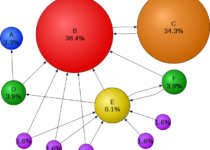How Geometric Design Principles Transform Brand Recognition
The most memorable brands share a hidden common denominator—thoughtful application of geometric design principles. Shapes convey certain emotions, which develop a brand’s unique identity.
Nike’s swoosh, Apple’s clean interfaces, and Google’s material design communicate a powerful message without saying a word. For marketing professionals, understanding geometric design principles isn’t just about aesthetics—it’s about creating visual systems that drive measurable business results.
Key Takeaways
- Geometric design principles create measurable business results by establishing visual systems that communicate brand values instantly while guiding user behavior, as evidenced by companies achieving up to 45% growth in subscription rates through strategic implementation.
- Five core geometric design principles form the foundation of effective visual communication: balance (visual distribution), proportion (size relationships), rhythm (patterns), harmony (cohesive integration), and contrast (deliberate differentiation).
- Human perception science explains why geometric design principles work through Gestalt theory, which shows how our brains process visual patterns as wholes rather than individual components, making properly designed geometries more memorable and effective.
- Implementing geometric design principles requires systematic strategy including auditing your visual ecosystem, developing frameworks, testing different arrangements, creating modular systems, and documenting guidelines for consistency.
- Emerging technologies are transforming geometric design applications with AI and computational design optimizing visual assets, while VR/AR testing allows teams to validate geometric arrangements before physical implementation.
Understanding Geometric Design Fundamentals
Geometric design principles are visual elements using mathematical concepts and spatial relationships. These principles govern how shapes, lines, angles, and proportions interact to create meaningful compositions that communicate effectively and resonate with viewers.
At its core, geometric design creates order from potential visual chaos. It provides structure, consistency, and logical organization that guides the human eye and mind. These fundamental principles transcend industry boundaries—from branding to architecture and digital interfaces.
“Geometric design isn’t just about making things look good—it’s about creating visual systems that function intuitively while communicating brand values instantly. When applied strategically, these principles become invisible forces guiding user behavior and emotional connection.” — Theodore Cipolla, Design Director
The growing importance of geometric design isn’t just anecdotal. According to BeeGraphy, 78% of new architectural projects in 2025 incorporate parametric design elements—a sophisticated application of geometric principles that allows for complex forms while maintaining mathematical relationships. This trend isn’t isolated to architecture; it’s spreading across all visual disciplines.
Core Geometric Design Principles
Shapes are one of the most basic elements of art. Understanding the elements of geometric design helps marketers communicate with designers and evaluate visual materials through a more strategic lens:
| Principle | Definition | Marketing Application |
|---|---|---|
| Balance | Visual distribution of weight between elements | Creates stability or intentional tension in brand communications |
| Proportion | Relative size relationships between elements | Establishes hierarchy and guides user attention to key messages |
| Rhythm | Predictable patterns creating visual movement | Builds recognition through consistent brand applications |
| Harmony | Cohesive integration of all design elements | Ensures brand communications feel unified across touchpoints |
| Contrast | Deliberate differentiation between elements | Creates visual interest and directs user attention to calls-to-action |
These principles aren’t just theoretical concepts—they directly impact how consumers perceive and interact with brands. For example, symmetrical balance conveys stability and trustworthiness, making it ideal for financial institutions, while asymmetrical compositions create energy and modernity, better suited for technology or entertainment brands.
The Science of Perception: Why Geometric Design Works
At their core, geometric shapes influence perception. The effectiveness of geometric design principles is rooted in cognitive psychology, particularly in how our brains process visual information. Gestalt theory—which explains how humans perceive whole patterns rather than individual components—provides scientific backing for why specific geometric arrangements resonate more powerfully than others.
Key Gestalt principles that influence geometric design include:
- Proximity: Elements positioned close together are perceived as related.
- Similarity: Objects sharing visual characteristics appear grouped.
- Continuity: The eye naturally follows paths or lines.
- Closure: The mind fills in gaps to complete familiar shapes.
- Figure/ground: How we differentiate objects from their background.
These principles explain why logos like FedEx (with its hidden arrow created through negative space) create such lasting impressions. They leverage innate human perception tendencies to create visual shortcuts to brand recognition.
Industry Applications of Geometric Design
From engineering to branding, there are many ways that businesses can use geometric design.
Branding and Identity
Geometric design is unique and memorable, serving as a robust brand recognition tool. That said, brands should approach geometric branding thoughtfully, and their shapes should communicate their goals or what they offer.
Linearity, a graphic design software company, leveraged geometric design principles to stand out in a crowded market. They developed comprehensive guidelines integrating shapes, lines, and symmetry into their Linearity Curve software. As a result, they achieved a 32% increase in user engagement and a 45% growth in subscription rates from professionals specifically seeking geometric design capabilities.
This example illustrates how geometric frameworks enhance aesthetics—they drive measurable business outcomes by creating more intuitive, recognizable brand systems.
User Experience and Interface Design
Geometric principles are the backbone of forming navigable and intuitive interfaces. Grid systems—themselves geometric frameworks—create consistent layouts that users understand. Web developers and designers can use these principles to organize content and improve readability. As a result, your website will reduce cognitive load and increase usability.
Consider the best practices for delivering exceptional digital experiences—creating visual hierarchy, guiding user flows, and establishing consistency across platforms. These principles translate directly into improved conversion rates and reduced bounce rates.
Engineering and Infrastructure
While marketing professionals may not directly work in transportation engineering, understanding how geometric design principles operate offers valuable insights into structure and functionality that can inform marketing approaches.
Geometric design in engineering optimizes safety and efficiency. The Federal Highway Administration (FHWA) demonstrates this through its approach to roadway design. In 2024, they introduced the Safe System Roadway Design Hierarchy as a framework for infrastructure-based countermeasures. This systematic application of geometric principles to roadway design resulted in a 17% reduction in run-off-road crashes on retrofitted rural highways within just 12 months.
The lesson for marketers? Geometric systems aren’t just about aesthetics—when applied with purpose and precision, they solve functional problems and create measurably better experiences.
Technology and Innovation in Geometric Design
The intersection of geometric design principles with emerging technologies creates unprecedented opportunities for brands to test, refine, and implement sophisticated visual systems.
AI and Computational Design
Geometric deep learning—a specialized branch of artificial intelligence—is transforming how companies approach design challenges. Altair, an engineering software company, implemented its physics AI platform utilizing geometric deep learning to predict physics outcomes based on existing simulations. This approach allowed them to significantly reduce development time and costs while enhancing product sustainability and safety.
For marketing teams, similar AI tools are emerging that can analyze existing visual assets against geometric principles and suggest optimizations to improve brand recognition and user engagement.
VR and AR Testing
Virtual reality is revolutionizing how designers test geometric principles before implementation. According to Hoefer Welker, 65% of architectural firms use VR and AI to test geometric balance before construction. Forward-thinking marketing teams adopt the same approach to pre-test environmental branding, retail displays, and experiential marketing installations.
These technologies allow designers to validate geometric arrangements in immersive environments, gathering data on user response before making significant investments in physical production.
Implementing Geometric Design in Your Marketing Strategy
Leveraging geometric design is more than just using bold shapes and clean lines. Companies will apply geometric design across their online branding and product packaging, and the artwork should be precise and modern. Follow these steps to create a cohesive geometric design across all platforms and packaging for recognizable branding.
- Audit your visuals: Evaluate existing brand materials through the lens of geometric principles. Look for inconsistencies in proportions, balance issues, or missed opportunities to establish visual rhythm.
- Develop frameworks: Work with designers to establish grid systems, proportion guides, and spatial relationships that can be consistently applied across all marketing materials.
- Test and measure: Implement A/B testing to compare user engagement with different geometric arrangements. Track metrics like attention time, click-through rates, and conversion to understand which applications of geometry perform best.
- Create modular systems: Design geometric components that can be recombined in multiple ways while maintaining a consistent visual language—perfect for social media templates, presentation decks, and campaign materials.
- Document for consistency: Develop clear guidelines on geometric aspects of your brand, including proportions, spacing, and structural grids, to ensure consistency across teams and channels.
These implementations directly contribute to conversion rate optimization by creating more intuitive, visually cohesive user experiences that guide prospects through their decision journey with visual clarity.
Future Trends in Geometric Design
Geometric design will always look balanced yet bold. However, there are geometric design trends that brands should expect, ranging from style to technological advances.
- Adaptive geometries: Dynamic systems that respond to user behavior, device contexts, or environmental factors are becoming increasingly sophisticated. These responsive frameworks maintain geometric integrity while adapting to different viewing scenarios, which is crucial for brands operating across diverse digital and physical touchpoints.
- Sustainable design: Geometric efficiency is becoming intertwined with sustainability concerns. Designs that optimize material usage, reduce waste, and create multipurpose solutions are gaining preference for environmental reasons and their ability to communicate brand values visually.
- Cross-cultural geometries: As brands operate globally, geometric systems that work effectively across cultural contexts are becoming essential. There’s growing recognition that geometric perception has universal and culturally-specific aspects that must be considered for truly global brands.
The Value of Geometric Design
Geometric design principles offer marketing professionals far more than aesthetic guidelines—they provide frameworks for creating visual systems that communicate effectively, function intuitively, and build brand recognition systematically. When brands include shapes in their logos and visuals, they drive measurable business results through enhanced user experience and brand recognition.
For companies looking to optimize their digital presence through these principles, working with the leading CRO agency can help translate geometric design theory into a conversion-driven strategy that aligns visuals with business objectives.
The post How Geometric Design Principles Transform Brand Recognition appeared first on Single Grain.


